Rock (geology)
A rock is any naturally occurring solid mass or aggregate of minerals or mineraloid matter. It is categorized by the minerals included, its chemical composition and the way in which it is formed. Rocks are usually grouped into three main groups: igneous rocks, metamorphic rocks and sedimentary rocks. Rocks form the Earth's outer solid layer, the crust.
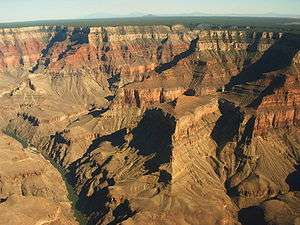
Igneous rocks are formed when magma cools in the Earth's crust, or lava cools on the ground surface or the seabed. The metamorphic rocks are formed when existing rocks are subjected to such large pressures and temperatures that they are transformed—something that occurs, for example, when continental plates collide. The sedimentary rocks are formed by diagenesis or lithification of sediments, which in turn are formed by the weathering, transport, and deposition of existing rocks.[1]
The scientific study of rocks is called petrology, which is an essential component of geology.[2]
Classification

Rocks are composed of grains of minerals, which are homogeneous solids formed from a chemical compound arranged in an orderly manner.[3] The aggregate minerals forming the rock are held together by chemical bonds. The types and abundance of minerals in a rock are determined by the manner in which it was formed.
Most rocks contain silicate minerals, compounds that include silicon oxide tetrahedra in their crystal lattice, and account for about one-third of all known mineral species and about 95% of the earth's crust.[4] The proportion of silica in rocks and minerals is a major factor in determining their names and properties.[5]
Rocks are classified according to characteristics such as mineral and chemical composition, permeability, texture of the constituent particles, and particle size. These physical properties are the result of the processes that formed the rocks.[6] Over the course of time, rocks can transform from one type into another, as described by a geological model called the rock cycle. This transformation produces three general classes of rock: igneous, sedimentary and metamorphic.
Those three classes are subdivided into many groups. There are, however, no hard-and-fast boundaries between allied rocks. By increase or decrease in the proportions of their minerals, they pass through gradations from one to the other; the distinctive structures of one kind of rock may thus be traced gradually merging into those of another. Hence the definitions adopted in rock names simply correspond to selected points in a continuously graduated series.[7]
Igneous rock
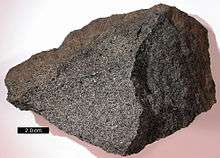
Igneous rock (derived from the Latin word igneus, meaning of fire, from ignis meaning fire) is formed through the cooling and solidification of magma or lava. This magma may be derived from partial melts of pre-existing rocks in either a planet's mantle or crust. Typically, the melting of rocks is caused by one or more of three processes: an increase in temperature, a decrease in pressure, or a change in composition.
Igneous rocks are divided into two main categories:
- Plutonic or intrusive rocks result when magma cools and crystallizes slowly within the Earth's crust. A common example of this type is granite.
- Volcanic or extrusive rocks result from magma reaching the surface either as lava or fragmental ejecta, forming minerals such as pumice or basalt.[6]
The chemical abundance and the rate of cooling of magma typically forms a sequence known as Bowen's reaction series. Most major igneous rocks are found along this scale.[5]
About 65% of the Earth's crust by volume consists of igneous rocks, making it the most plentiful category. Of these, 66% are basalt and gabbro, 16% are granite, and 17% granodiorite and diorite. Only 0.6% are syenite and 0.3% are ultramafic. The oceanic crust is 99% basalt, which is an igneous rock of mafic composition. Granite and similar rocks, known as granitoids, dominate the continental crust.[8][9]
Sedimentary rock
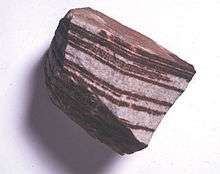
Sedimentary rocks are formed at the earth's surface by the accumulation and cementation of fragments of earlier rocks, minerals, and organisms[10] or as chemical precipitates and organic growths in water (sedimentation). This process causes clastic sediments (pieces of rock) or organic particles (detritus) to settle and accumulate, or for minerals to chemically precipitate (evaporite) from a solution. The particulate matter then undergoes compaction and cementation at moderate temperatures and pressures (diagenesis).
Before being deposited, sediments are formed by weathering of earlier rocks by erosion in a source area and then transported to the place of deposition by water, wind, ice, mass movement or glaciers (agents of denudation).[6] About 7.9% of the crust by volume is composed of sedimentary rocks, with 82% of those being shales, while the remainder consists of limestone (6%), sandstone and arkoses (12%).[9] Sedimentary rocks often contain fossils. Sedimentary rocks form under the influence of gravity and typically are deposited in horizontal or near horizontal layers or strata, and may be referred to as stratified rocks.[11]
Metamorphic rock
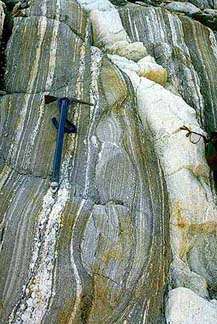
Metamorphic rocks are formed by subjecting any rock type—sedimentary rock, igneous rock or another older metamorphic rock—to different temperature and pressure conditions than those in which the original rock was formed. This process is called metamorphism, meaning to "change in form". The result is a profound change in physical properties and chemistry of the stone. The original rock, known as the protolith, transforms into other mineral types or other forms of the same minerals, by recrystallization.[6] The temperatures and pressures required for this process are always higher than those found at the Earth's surface: temperatures greater than 150 to 200 °C and pressures of 1500 bars.[12] Metamorphic rocks compose 27.4% of the crust by volume.[9]
The three major classes of metamorphic rock are based upon the formation mechanism. An intrusion of magma that heats the surrounding rock causes contact metamorphism—a temperature-dominated transformation. Pressure metamorphism occurs when sediments are buried deep under the ground; pressure is dominant, and temperature plays a smaller role. This is termed burial metamorphism, and it can result in rocks such as jade. Where both heat and pressure play a role, the mechanism is termed regional metamorphism. This is typically found in mountain-building regions.[5]
Depending on the structure, metamorphic rocks are divided into two general categories. Those that possess a texture are referred to as foliated; the remainders are termed non-foliated. The name of the rock is then determined based on the types of minerals present. Schists are foliated rocks that are primarily composed of lamellar minerals such as micas. A gneiss has visible bands of differing lightness, with a common example being the granite gneiss. Other varieties of foliated rock include slates, phyllites, and mylonite. Familiar examples of non-foliated metamorphic rocks include marble, soapstone, and serpentine. This branch contains quartzite—a metamorphosed form of sandstone—and hornfels.[5]
Human use
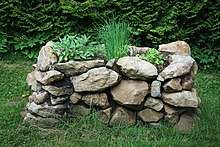
The use of rock has had a huge impact on the cultural and technological development of the human race. Rock has been used by humans and other hominids for at least 2.5 million years.[13] Lithic technology marks some of the oldest and continuously used technologies. The mining of rock for its metal content has been one of the most important factors of human advancement, and has progressed at different rates in different places, in part because of the kind of metals available from the rock of a region.
Mining
Mining is the extraction of valuable minerals or other geological materials from the earth, from an ore body, vein or seam.[14] The term also includes the removal of soil. Materials recovered by mining include base metals, precious metals, iron, uranium, coal, diamonds, limestone, oil shale, rock salt, potash, construction aggregate and dimension stone. Mining is required to obtain any material that cannot be grown through agricultural processes, or created artificially in a laboratory or factory. Mining in a wider sense comprises extraction of any resource (e.g. petroleum, natural gas, salt or even water) from the earth.[15]
Mining of rock and metals has been done since prehistoric times. Modern mining processes involve prospecting for mineral deposits, analysis of the profit potential of a proposed mine, extraction of the desired materials, and finally reclamation of the land to prepare it for other uses once mining ceases.[16]
Mining processes may create negative impacts on the environment both during the mining operations and for years after mining has ceased. These potential impacts have led to most of the world's nations adopting regulations to manage negative effects of mining operations.[17]
See also
References
- Tarbuck; Lutgens, s 194
- Harbaugh, John W.; Windley, Brian Frederick. "Geology". Encyclopædia Britannica. Retrieved 15 April 2019.
- Cipriani, Nicola (1996). The encyclopedia of rocks and minerals. New York: Barnes & Noble. ISBN 978-0-7607-0291-8.
- Heinen, Wouter; Oehler, John H. (1979). "Evolutionary Aspects of Biological Involvement in the Cycling of Silica". In Trudinger, P.A.; Swaine, D.J. (eds.). Biogeochemical Cycling of Mineral-Forming Elements. Amsterdam: Elsevier. p. 431. ISBN 9780080874623. Retrieved 13 April 2020.
- Wilson, James Robert (1995), A collector's guide to rock, mineral & fossil localities of Utah, Utah Geological Survey, pp. 1–22, ISBN 978-1-55791-336-4, archived from the original on 19 November 2016.
- Blatt, Harvey; Tracy, Robert J. (1996). Petrology (2nd ed.). W.H. Freeman. ISBN 978-0-7167-2438-4.
-

- Condie, Kent C. (2015). Plate Tectonics & Crustal Evolution (2nd ed.). New York: Pergamon. p. 68. ISBN 9781483100142. Retrieved 13 April 2020.
- Bucher, Kurt; Grapes, Rodney (2011), Petrogenesis of Metamorphic Rocks, Heidelberg: Springer, pp. 23–24, ISBN 978-3-540-74168-8, archived from the original on 19 November 2016.
- Gilluly, James (1959). Principles of Geology. W.H. Freeman.
- Monroe, James S.; Wicander, Reed (2008). The Changing Earth: Exploring Geology and Evolution (5th ed.). Belmont, CA: Brooks/Cole. p. 438. ISBN 9780495554806. Retrieved 13 April 2020.
- Blatt, Harvey and Robert J. Tracy, Petrology, W.H.Freeman, 2nd ed., 1996, p. 355 ISBN 0-7167-2438-3
- William Haviland, Dana Walrath, Harald Prins, Bunny McBride, Evolution and Prehistory: The Human Challenge, p. 166
- Gajul, Shekhar (28 July 2018). "Underground Mining Equipment Market 2017 Global Key Players, Share, Challenges, Industry Size, Growth Opportunities & Forecast To 2021". Journalist Book.
- Botin, J.A., ed. (2009). Sustainable Management of Mining Operations. Denver, CO: Society for Mining, Metallurgy, and Exploration. ISBN 978-0-87335-267-3.
- Wilson, Arthur (1996). The Living Rock: The Story of Metals Since Earliest Times and Their Impact on Developing Civilization. Cambridge, England: Woodhead Publishing. ISBN 978-1-85573-301-5.
- Terrascope. "Environmental Risks of Mining". The Future of strategic Natural Resources. Cambridge, Massachusetts: Massachusetts Institute of Technology. Archived from the original on 20 September 2014. Retrieved 10 September 2014.